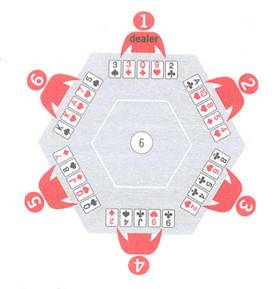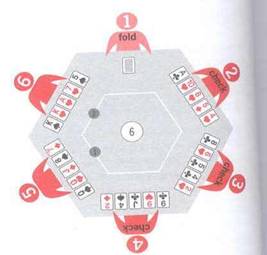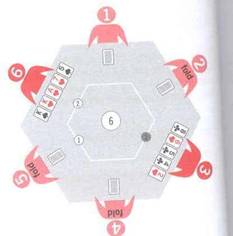How to lose money quickly
In preceding tables, particularly Table 10, we have listed chances of improving hands at the draw, and we make no excuses for repeating the idea that betting heavily on a hand that could be a good one after the draw, inexperienced players to lose plenty of cash.
It is an example, never worth betting with a hand like J, 8,7,6,4 of assorted suits, where the only chance of improving, albeit to a very good hand, is to discard the Jack and hope to draw a 5 for a straight. The odds against success are nearly 11 to 1, and the pot will never justify such a gamble. From this example, the general principle can be drawn that relying optimistically on a draw is dangerous tactic.
EXAMPLE RISKY BUSINESS
This deal involves six players; therefore there are six chips in the pot. The limit is one chip to bet or raise before the draw, two chips after the draw. Player 1 is the dealer and you are player 6.
First betting interval
FIRST BETTING ROUND
- Player 2 checks, as do 3 and 4.
- Player 5 opens with his pair of Queens, making the pot up to seven chips.
- As player 6, you can guess that players 2, 3 and 4 probably hold less than a pair of Jacks, or they would probably have opened the betting intervals. You could assume that player 5 might hold at least a pair of Jacks or Queens.

THE DEAL Players 6’s betting in his hand will depend largely on the bets on the preceding players.
He could hold a pair of aces or better, but as you hold an Ace and a pair of Kings you can take a view for now that if he holds a pair, it is probably no better than Queens (the number of cards he draws will indicate if he has better than a pair). With your pair of Kings, and with only the dealer to speak, you think you have a good chance of holding the best hand currently held. What to do? Obviously you will not fold, but should you call or raise? There is a good case here to raise.
If the kings are the best hand, you do not want several players staying in the poker game and drawing, and possibly beating your hand. For example, if you call, and player 4 calls, (irrespective of what players 1, 2 and 3 might do) and players 4 and 5 stay in with you for the draw, player 4 might well draw another 9 or a second pair, and take the pot. On the other hand if you raise, you would probably force player 4 into folding, leaving you perhaps with one opponent for the pot. So you call and raise by putting in two chips, the pot now being nine chips.

1ST BETTING ROUND Player’s 6’s strategy of raising player 5’s bet has scared off player 1.
- Player, 1, the dealer, faced with a bet and a raise, decides his pair of 3s is not worth risking two chips with and folds. Your strategy is working, because had he stayed in he might have drawn a third 3.
SECOND BETTING ROUND
- Player 2 folds (he would need to draw an Ace to have much chance, and it is not it is not worth the bet).
- Player 3 decides to stay in and draw one card to his 8,6,5,4, hoping to draw a 7 to complete a straight which, were he successful, would probably win the hand. (Note: he could also have discarded the 8, hoping to draw a 3.) To call costs him two chips, raising the pot to 11 chips. Notice that when player 3 makes his decision to call, there are nine chips in the pot, for which he risks two more chips to get his straight. If he is successful he wins nine (odds of 9 to 2), but we know the real odds of him converting to a straight are nearly 11 to 1, so this is a sucker bet.
- Player 4 now folds, because with three players still in his pair of 9s is too weak to bet on.
- Player 5, having opened the betting on a pair of Queens, also decides to fold, assuming that you probably hold something like a pair of aces or better, and that player 3 also has a hand worth betting.

2ND BETTING ROUND In this round, players 2, 4 and 5 all fold, while player 3 thinks his possible flush straight is worth staying in for.
As all bets are equalized, the first betting interval now ends and you (player 6) have one rival, player 3, for a pot currently standing at 11 chips
